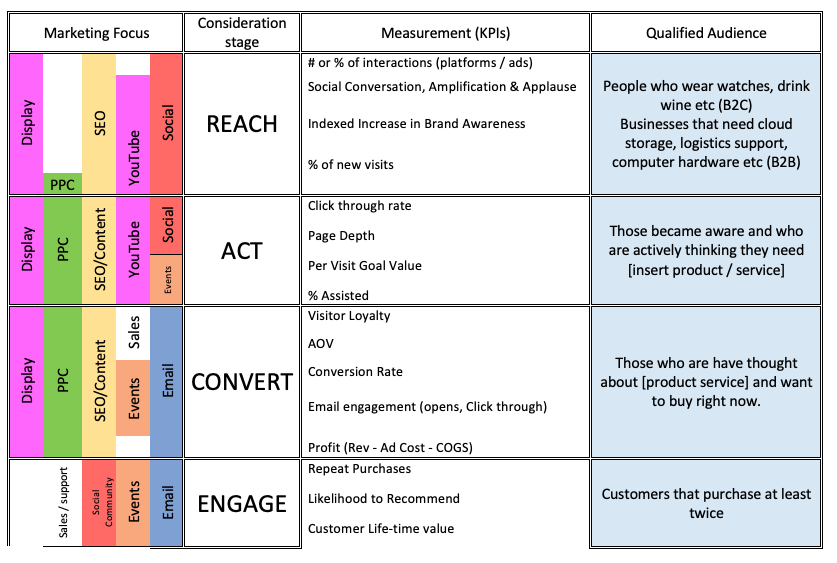Most successful businesses will have a digital marketing plan that will include need to use several different digital channels. And the greater the number of digital channels you use, it will be very important to know how each of these channels work for your business and how they work together.
When looking at digital channels you need to be aware that:
- Each digital channel layers on the next, so that they can (well managed well) to become greater than the sum of their parts.
- The different digital channels have a different place in the customer journey. Some will be better at achieving awareness and others will often be the source of the actual conversion.
- Understanding the way in which they work together means that you can allocate your budget to maximise the value from your digital marketing.
According to report by the McKinsey Group, the top 10% of companies with the best digital skills had on average 2.5 times the sales of those at the lower end. So, it is worth the effort to optimise your digital efforts.
It is typical for a potential customer to have multiple interactions with your digital marketing particularly visits to your website before they become a lead or customer. And the channel they use when they convert is not necessarily (or likely) to be the one that was the initial contact with your business or your products / services.
Not all channels are created equal and as such they will be suited to different marketing tasks. Have a look at a simple Sales Funnel using the RACE methodology. The table below shows an example of the RACE. Under “Marketing Focus”, I have included most of the most popular digital channels and where they would be used at each stage of the customer journey.
Some channels are much better suited to reaching out to potential customers and make them aware of your products. Other channels will be more effective in helping the prospective customers to take action or convert. The qualified audience column identifies the attitudes of the audience as they encounter your communication.

To take the example of a social channel, it is likely to be the first interaction source for a new customer. This is because if the customer doesn’t know you then he or she won’t be visiting your website and checking out your products. This is especially true when the customer is actively searching for a product or service but would be interested if they were presented with a compelling proposition, they will investigate further.
Side Bar: Buyers and Shoppers
One way of looking at purchasers is to see two types: shoppers and buyers. Shoppers have an immediate problem to solve and they need to purchase a particular product or service. If it’s not your product then it will be someone else. Buyers however are not looking for the product, but they may be willing to purchase if the proposition is compelling.
Most products tend to be needed by either shoppers or buyers. Understanding whether your potential customers are a buyer or shopper will influence your digital strategy. For example, search advertising (pay per click) is going to be much more effective for shopper products than buyer products.
When they are aware of you, it is likely that they will find an easier way to your business, perhaps from a pay per click advert, organic search or by typing in the web address.
So, what is the problem?
If we have a channel that makes your audience aware of your product but does not seem to create conversions, should we stop using it
No. What we need to do next is to figure out what different channels are worth? We need what is known as attribution modelling.
Attribution Modelling
So, what is attribution modelling? Given that a customer may have many touchpoints and visit the website several times on their journey attribution modelling attempts to apportion a share of the conversion to other interactions before conversion.
The table below shows an example of a business that uses several digital channels as part of their business. There are several ways of measuring attribution:
- Last Interaction: this is the most common way of measuring attribution. In this case, all the value of the conversion goes to the last visit.
- First Interaction: this gives the value of the conversion to the first digital channel that resulted in the conversion.
- Time Delay: the conversion is shared among each channel that caused the visits. However, more value is given to later visits and gradually reduce in value for earlier visits.
- Position Based: shares the value of the conversion to the different channels based on the position of the visit. So, you may give 40% to the Last Interaction and 40% for the First Interaction. The remainder of the conversion value to be shared among the other visits.
- Custom model: for confident analysts, you can create your own bespoke version.
In the table below, three models are compared, “Last Interaction”, “First Interaction” and “Position Based”. Looking at Direct and Organic Search, channels and based on the “Last Interaction”, Direct is the most effective channel for conversions (111). However, when you compare it to “First Interaction”, Direct Conversions drops to 64. The number of conversions from Organic Search increases from 68 to 104.
This suggests that Organic is much better at drawing people onto the site in the first place. But on their return, because the visitor is aware of the site, they are likely to use Direct channel because the site would be stored in the browser.

The point here is that understanding how effective Organic Search is in promoting your products and services and bring visitors to the site. This will now give you a much better idea of the value of the channels. Looking at Paid Search, Referral, Social Networks. Each of these channels increase in the number conversions under the “First Interaction” model. This suggests that they are better higher up the funnel – creating awareness and interest.
Conclusion
Understanding how well your digital channels work individually and how much more powerful when they work together.
If you are only crediting the digital channels that give you the conversion, you are likely to fail to understand the true values of all your digital sources. By measuring the channels that also assist in the conversion too. These higher funnel channels should be given credit for assisting in achieving a conversion by another channel it increases its value to the business.
Attribution modelling helps you to measure and control your digital channels, from those that provide value by creating awareness and interest among your audience and those that are just burning cash.

